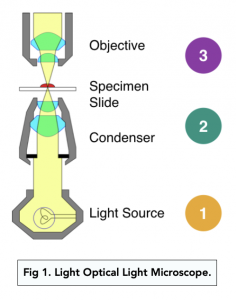Studying Cells: Light Microscopes (A-level Biology)
Studying Cells: Light Microscopes
Microscopy
- Microscopy is a scientific field involved with microscopes. The field of microscopy studies how to develop and use microscopes to visualise biological processes.
- There are three main types of microscopes. There are three major types of microscopy that we will discuss in this section that you should familiarise yourself with – optical light microscopes, electron microscopes, and confocal microscopes.
Optical Light Microscopy
- Optical microscopes use white light to illuminate a specimen.
-
- Light passes through the specimen
- Into the magnifying lenses of the microscope
- Into the objective viewing lenses
- Into the observer’s eye where the brain forms an image. The light can also pass to a camera linked to a computer which can display the image on a screen.
-
- Limitation: Low Resolution. Because optical microscopes use normal white light, the limit of their resolution is 200 nanometres. This means that objects smaller than this cannot be properly viewed by an optical microscope. In cells, this means that optical microscopes cannot be used to properly study ribosomes, endoplasmic reticula, and lysosomes.
- Limitation: Low Magnification. The maximum magnification is x1500. Any magnification beyond this is useless because of the relatively low resolution of optical microscopes.

Preparing Specimens for Light Microscopy
Stains
- Stains help visualise specimens better. We have established that light microscopy works due to light passing through our specimen. If our specimen is transparent, light rays will completely pass through the sample and will not result in an adequate image. Special stains, usually dyes for light microscopy, can be used on specimens like this to help the image form.
- Common stains include eosin and methylene blue. Eosin stains the cytoplasm pink, while methylene blue stains DNA and RNA blue.
- Multiple stains can be used together. As different stains are picked up by different structures, more than one stain can be used when preparing a specimen so that the best image can be achieved.
Preparing the Slide
A sample needs to first be placed on a microscope slide before it can be viewed under a light microscope.
- The specimen needs to be as thin as possible. A thin specimen will allow light to pass through. As such, thick specimens will need to be sliced down into the thinnest sample possible.
- There is a “dry mount” and a “wet mount”. Your specimen can be placed directly onto the microscope slide, in which case, it is called a “dry mount“. In a “wet mount“, you first need to place a drop of water onto the microscope slide, into which you will place your specimen. The mount you choose will depend upon your specimen e.g. dry mounts are good for studying specimens like pollen while wet mounts are better for studying aquatic organisms.
- Stains are used with wet mounts. The details of how to prepare one are outlined below.
- Preparing a dry mount:
- Place your specimen in the middle of a clean microscope slide using tweezers.
- Place a cover slip on top of the specimen. The cover slip will hold the specimen in place and prevent it from getting damaged.
- Preparing a wet mount:
- Using a pipette, place a drop of water onto the middle of a clean microscope slide.
- Place your specimen into the water drop using tweezers.
- Place a cover slip on top of the specimen. Extra care needs to be taken with a wet mount as you may trap air bubbles underneath. Start by standing the cover slip upright on its edge over the specimen, then using your tweezers, carefully lower it into place.
- Add any necessary stains after the cover slip is in position. Place a drop of the stain at one side of the cover slip. Then, place a paper towel against the edge of the opposite side. This will draw the stain under the cover slip and across the specimen. You may need to add another drop to ensure the specimen is fully stained, or you may wish to repeat this process with a different stain.

Cells are the basic unit of life in biology. They are the smallest structures that can perform all the functions necessary for life, and they make up all living organisms, including plants, animals, and humans.
Studying cells is important in biology because it helps us understand the basic structure and functions of living organisms. This knowledge is crucial for understanding cellular processes such as metabolism, growth, and reproduction.
A light microscope is a type of microscope that uses light to magnify the image of a specimen. It works by passing light through a specimen and focusing the light on an eyepiece or camera, which magnifies the image.
The components of a light microscope include:
Objectives: lenses that focus the light and magnify the image
Eyepiece: lens that magnifies the image
Light source: provides the illumination needed to see the specimen
Condenser: focuses the light onto the specimen
Stage: holds the specimen in place
Diaphragm: controls the amount of light that reaches the specimen
There are several types of light microscopes, including:
Simple light microscope
Compound light microscope
Stereo microscope
Fluorescence microscope
Confocal microscope
A light microscope helps in the study of cells by allowing us to observe the structures and functions of cells in great detail. This allows us to better understand the processes that occur within cells, such as metabolic reactions and cell division.
The limitations of light microscopy in the study of cells include the limited resolution of the images produced and the difficulty in observing internal structures within cells.
In A-Level Biology, knowledge of light microscopy is important for understanding cellular structure and function, as well as for observing the effects of different treatments and conditions on cells. This knowledge is also important for understanding related medical conditions, such as cancer and infectious diseases.






Still got a question? Leave a comment
Leave a comment